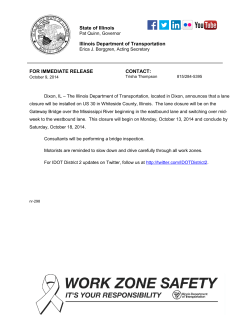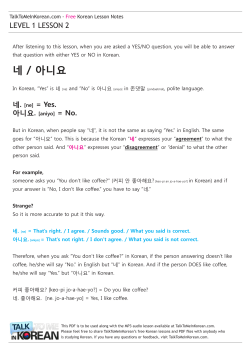
Document 352626
An Electropalatographic Study of Korean coronal obstruents Yoonjung Kang1,2 Alexei Kochetov1 1University of Toronto 2University of Toronto Scarborough MOT Carleton University March 12-‐14, 2010 Introduc@on • Place of ar@cula@on of Korean affricates: – Phonological interac@on with high front vocoids – Post-‐alveolar, palatal, alveolo-‐palatal, etc. – [-‐anterior], [+high, -‐back] or V-‐pl [Coronal] • Previous ar@culatory studies: – Closure: den@-‐alveolar • Current EPG study: – Linguopalatal contact paOern during closure and frica@on por@on of affricates compared with coronal stops and frica@ves Korean coronal obstruents Lenis For@s Aspirated Stops t t' th Affricates c c' ch Frica@ves s s' Phonological paOerning of Korean affricates (i) • Affrica@on (a.k.a. “Palataliza@on”) – Coronal stops become affricates before a high front vowel or glide. – Applies across morpheme boundaries only. /mat-i/ [maci] ‘the eldest’ /kath-i/ [kachi] ‘together’ cf. /titi-ta/ [titita](<tɨjtɨjta) *[cicita] ‘to tread’ Phonological paOerning of Korean affricates (ii) • Yod-‐dropping – Within a morpheme: *Coronal obstruent + j – Derived sequences of coronal obstruent + j • Stops and frica@ves: contrast Cj vs. C /pʌthi-ʌ/ à [pʌthjʌ] ‘to withstand’ /mɑsi-ʌ/ (à [masjʌ]) à [maʃʌ] ‘to drink’ • Affricates /kaci-ʌ/ (à [kacjʌ]) à [kacʌ] ‘to have’ /tachi-ʌ/ (à [tachjʌ]) à [tachʌ] ‘to get hurt’ Phonological paOerning of Korean affricates (iii) • Umlaut [api] [aki] ~ ~ [æpi] [æki] ‘father’ ‘baby’ • Intervening coronals, palatals (i.e., affricates and derived palatals) in par@cular, tend to block Umlaut. [tacita] ~ [kachi] ~ *[tæcita] *[kæchi] ‘to mince’ ‘value’ Feature specifica@on • Primary constric@on: [-‐anterior] • Secondary ar@cula@on: [-‐back, +high] or V-‐pl [Coronal] (Hume 1990, Kiparsky 1993, etc.) Previous ar@culatory studies • X-‐ray (Skaličková 1960, cited in H. Kim 2001) • Sta@c palatography (H. Kim 2001, Anderson et al. 2003) • Electropalatography (Shin 1996, Baik 2003) • MRI (H. Kim 2004) Previous studies: Primary constric@on • Den@-‐alveolar • Laminal or apico-‐laminal (Anderson et al. 2003) Previous studies: Secondary ar@cula@on • Affricates have a rela@vely higher tongue body posi@on than stops, although not as extreme as contras@vely palatalized consonants such as Russian /ʧj/ (H. Kim 2005). Remaining ques@on: primary constric@on • Previous studies on Korean affricates mostly focused on the closure por@on. • Does the release por,on of affricates have “posterior” constric,on? Cf. Recasens and Espinosa (2007): – EPG study – alveolar /ʦ ʣ/ vs. alveolopalatal /ʧ ʤ / in two dialects of Catalan – The anteriority contrast was more substan@al during frica@on than during closure. Remaining ques@on: secondary ar@cula@on • Do affricates have more palatalized tongue body posi,on than alveolar stops or frica,ves? Cf. H. Kim (2004, 2005)’s MRI study is limited to stops vs. affricates in /a_a/ context only. Design • Par@cipants – 1 male (M1) and 2 female (F1, F2) Seoul Korean speakers. • S@muli – C: t t’ th c c’ ch s s’ (p k h n l j) – V: a i u (ɨ ʌ jʌ) – “maCV”: mostly nonsense words; but some are real words. – Carrier Sentence: ice maCV-‐rako malhæjo ‘Say maCV now.’ • 3 repe@@ons * 2 rounds = 6 tokens per s@muli Electropalatography • Instrumenta@on: – A WinEPG system (Wrench et al. 2002) with EPG data sampled at 100 Hz, acous@cs at 22,050 Hz. – Custom-‐made ar@ficial palates with 62 electrodes constructed for each par@cipant. Measurements • Closure: – the frame of maximum EPG contact during the closure • Frica@on: – the midpoint of frica@on. The onset and offset of frica@on was determined based on the spectrogram. M1 /mac’a/ d Primary constric@on Secondary ar@cula@on (palataliza@on) R1 R2 R3 R4 R5 R6 R7 R8 (Fontdevila, et al. 1994) Primary constric@on: maximum closure Stops Affricates M1 alveolar alveolar ~ (postalveolar) F1,2 alveolar ~ (postalveolar) alveolar ~ (postalveolar) Mean contact ra@o per row at maximum closure (R1-‐R5) Mean contact ra@o at maximum closure (R1-‐R5) Affricates are overall very consistent in contact paDern compared to stops. Mean contact ra@o per row at maximum closure: alveolar (R1-‐R2) and postalveolar(~prepalatal) (R3-‐R5) zones F1,2: -‐ affricates and stops have almost idenJcal contact paDern. Mean contact ra@o per row at maximum closure: alveolar (R1-‐R2) and postalveolar(~prepalatal) (R3-‐R5) zones F1,2: -‐ affricates and stops have almost idenJcal contact paDern. -‐ slightly less posterior contact for stops than for affricates Mean contact ra@o per row at maximum closure: anterior (R1-‐R2) and postalveolar(~prepalatal) (R3-‐R5) zones M1: -‐ stops are mainly denJ-‐ alveolar -‐ far less alveolar and posterior contact for stops than for affricates Primary constric@on: frica@on midpoint Frica@ves M1 [a u] alveolar alveolar F1,2 ~ (postalveolar) [i] Affricates postalveolar alveolar ~ (postalveolar) alveolar ~ (postalveolar) Mean contact ra@o per row at fricaJon midpoint (R1-‐ R5) Mean contact ra@o per row at fricaJon midpoint: alveolar (R1-‐R2) and postalveolar(~prepalatal) (R3-‐R5) Affricates are overall consistent in contact paDern compared to fricaJves. Mean contact ra@o per row at fricaJon midpoint: alveolar (R1-‐R2) and postalveolar(~prepalatal) (R3-‐R5) F1,2 [a u]: -‐ Affricates and fricaJves have similar contact paDern. -‐ Affricates have slightly less alveolar contact and slightly more postalveolar contact. Mean contact ra@o per row at fricaJon midpoint: alveolar (R1-‐R2) and postalveolar(~prepalatal) (R3-‐R5) M1 [a u]: -‐ FricaJves have (denJ)-‐alveolar contact and very liDle postalveolar contact Mean contact ra@o per row at fricaJon midpoint: alveolar (R1-‐R2) and postalveolar(~prepalatal) (R3-‐R5) [i] -‐ Affricates remain similar to [a u]. -‐ For fricaJves, the main contact shiQ to postalveolar before [i]. Interim summary: primary constric@on • Q1: Does the release por,on of affricates have “posterior” constric,on? – No. – The closure and the release por@on of Korean affricates have similar constric@on loca@on. – The affricate release and the frica@ve have similar constric@on loca@on. • The affricate constric@on is some@mes but not always more posterior than that of corresponding stops and frica@ves. Interim summary: primary constric@on • But, affricates have more stable realiza@on overall compared to stops and frica@ves. – Affricates consistently show alveolar(~postalveolar) constric@on: • across speakers • across vowel contexts and • both during the closure and the release – Stops and frica@ves show more variaJon: • den@-‐alveolar • alveolar(~postalveolar) • postaveolar Palatal contact (R6-‐R8) at maximum closure (M1, F1) M1, F1 Stops Affricates [a u] minimal contact minimal contact [i] more extensive contact minimal contact Palatal contact (R6-‐R8) at maximum closure (F2) F2 Stops Affricates [a u] minimal contact [i] more extensive contact Palatal contact (R6-‐R8) at maximum closure Quo@ent of palatal contact (Qp) Qp= [(R6 + R7 + R8)/24] Secondary ar@cula@on at maximum closure: palatal contact (R6-‐R8) [a u]: no clear difference between affricates and stops Secondary ar@cula@on at maximum closure: palatal contact (R6-‐R8) [i] F1, M1: increased palatal contact for stops but not for affricates Secondary ar@cula@on at maximum closure: palatal contact (R6-‐R8) [i] F2: increased palatal contact for both stops and affricates Secondary ar@cula@on at fricaJon midpoint: palatal contact (R6-‐R8) Interim summary: palatal contact • Q2: Do affricates have more palatalized tongue body posi,on than alveolar stops or frica,ves? – No. Contrary to H. Kim (2005) we did not find evidence for higher/fronter tongue body posi@on in affricates than in stops (or frica@ves). – For two speakers (M1, F1), in [i] context, stops and frica@ves had significantly more palatal contact than affricates. • In general, the affricates have more stable palatal contact paOern than the stops or frica@ves. – More resistant to coar@culatory influence of the following vowel. Discussion • The affricates are different from the corresponding stops and frica@ves: – not so much in the primary constric@on loca@on or the degree of palataliza@on per se, – but in the stability of its ar@culatory realiza@on. • The affricates are consistently alveolar-‐postalveolar while the stops and the frica@ves are more variable. • The affricates have a more stable tongue body target while the palataliza@on in stops and frica@ves are more contextually determined. Lingual coar@cula@on 100% • Propor@on of contexts 90% where coar@culatory difference in palatal contact 80% 70% (Qp) is sta@s@cally significant (Scheffe, p<.05) 60% 50% • Coar@culatory resistance affricate frica@ve stop 40% – Affricates > Frica@ves > Stops Cf. Recasens (1995) – factors affec@ng lingual coar@cula@on • coupling effects with primary ar@culator • aerodymanic requirement 30% 20% 10% 0% a-‐i a-‐u i-‐u Coar@culatory resistance and phonological ac@vity • Post-‐consonantal glides in Korean are phone@cally realized as secondary ar@cula@on on the consonants. • The difference in coar@culatory resistance is compa@ble with the asymmetrical paOerning of affricates and non-‐affricates in yod-‐dropping. – *Affricate + j – Stop + j: ok – Frica@ve +j: ok Referencs Anderson, V., I. Ko, W. O’Grady, & M. Choo. (2004). A palatographic inves@ga@on of place of ar@cula@on in Korean coronal obstruents. Korean Linguis?cs 12, 1-‐24. Baik, W. (2003). An EPG study of the ar@culatory difference between Korean and English affricates. Speech Sciences (The Korean Associa@on of Spech Science Quarterly) 10.4, 57-‐62. Kim, H. (2001a). A phone@cally based account of phonological stop assibila@on. Phonology 18, 81-‐108. Kim, H. (2001b). The place of ar@cula@on of the Korean plain affricate in intervocalic posi@on: an ar@culatory and acous@c study. Journal of the Interna?onal Phone?c Associa?on 31, 229– 237. Kim, H. (2004). Stroboscopic-‐cine MRI data on Korean coronal plosives and affricates: Implica@ons for their place of ar@cula@on as alveolar. Phone?ca 61, 234-‐251. Recasens, D. & A. Espinosa (2007). Affricates and frica@ves in two Catalan dialects. Journal of the Interna?onal Phone?c Associa?on 37, 143–172. … More Acknowledgements • Thanks to Sohyun Hong and Bojana Radovanovic for assistance with labeling EPG data and to the par@cipants • Work supported by the Connaught New Staff Matching Grant to Alexei Kochetov and by the Connaught New Staff Matching Grant to Yoonjung Kang M1 mapi M1 mapa
© Copyright 2025










